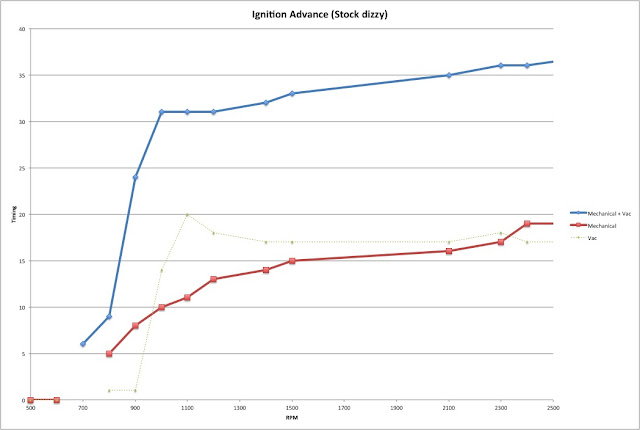Finally had some time to install an FJ60 dizzy in my 75, but before I did I wanted to baseline the stock vac advance one so I can compare the two.
This is the ignition advance curve from my original FJ40 distributor. I didn't notice until after swapping dizzys that my vac advance mechanism has leak in it. Looks like it still advances, but it won't hold vacuum. Not sure how much the vac leak affected my readings, I may try and rerun it again at a later date. Dotted line is the ported vacuum contribution to the advance

Here's the curve from an FJ60 large cap dizzy. Dashed lines are vacuum readings and correspond to the scale on the right. A couple things I noticed was the mech vac advance doesn't come on until after 1000 rpm, unlike the stock FJ40 which starts immediately off idle. Also, I wanted to see the difference between ported and manifold vac, it looks like the only difference is at low rpm, above 1300 rpm they pretty much follow the same curve. This agrees with what I've read on the web, but wanted to see it for myself. Using a hand held vacuum tester, it appears the advance mechanism doesn't start until about 1-3 inches of vac, and maxes out by 9-11 inches (or around 1200 rpm).

Just curious If this seems right. In terms of actual on road performance, there's a slight difference, but I haven't put on enough miles yet to verify. There is however a noticeable improvement in starting with the FJ60 dizzy. The engine runs smoother and quieter, I can idle down <500 rpm, and starts much quicker both cold and hot. I thought old dizzy was working ok, but I didn't really have anything to compare it to. I did have some problems with a slightly jumpy timing mark, which I attributed to either worn points or worn bushings, but the new one is rock solid.
This is the ignition advance curve from my original FJ40 distributor. I didn't notice until after swapping dizzys that my vac advance mechanism has leak in it. Looks like it still advances, but it won't hold vacuum. Not sure how much the vac leak affected my readings, I may try and rerun it again at a later date. Dotted line is the ported vacuum contribution to the advance

Here's the curve from an FJ60 large cap dizzy. Dashed lines are vacuum readings and correspond to the scale on the right. A couple things I noticed was the mech vac advance doesn't come on until after 1000 rpm, unlike the stock FJ40 which starts immediately off idle. Also, I wanted to see the difference between ported and manifold vac, it looks like the only difference is at low rpm, above 1300 rpm they pretty much follow the same curve. This agrees with what I've read on the web, but wanted to see it for myself. Using a hand held vacuum tester, it appears the advance mechanism doesn't start until about 1-3 inches of vac, and maxes out by 9-11 inches (or around 1200 rpm).

Just curious If this seems right. In terms of actual on road performance, there's a slight difference, but I haven't put on enough miles yet to verify. There is however a noticeable improvement in starting with the FJ60 dizzy. The engine runs smoother and quieter, I can idle down <500 rpm, and starts much quicker both cold and hot. I thought old dizzy was working ok, but I didn't really have anything to compare it to. I did have some problems with a slightly jumpy timing mark, which I attributed to either worn points or worn bushings, but the new one is rock solid.
Last edited:

